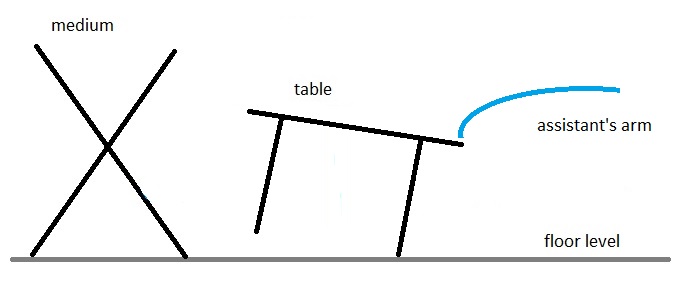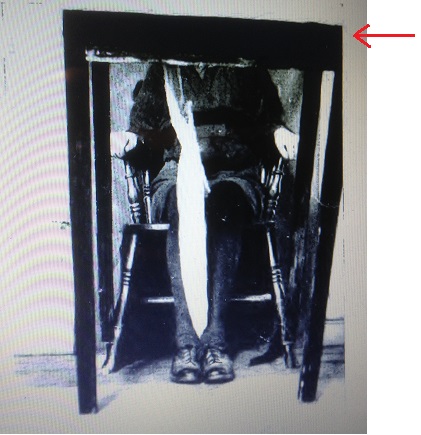Alternative methods for the same results
While I hate to be a party pooper, I do think it very important to consider the possibility of trickery. Crawford mentioned several times in his descriptions of the séances at the Goligher residence that the whole family was present at each of the séances, which puts 7 people in the room other than himself. As noted, the size of the table is not very great. Without taking sides, I do acknowledge the possibility that levitation of the table may have involved collusion with one or more of the other family members. I can imagine that when all eyes were on Miss Goligher, a relative may well have had a hand on the edge of the table to effect the movement normally attributed to ectoplasm.
This admittedly unkind supposition on my part is fueled by the observation by Crawford that Miss Goligher's brother Samuel was also capable of mediumistic feats. “It is rather a strange fact that pronounced mediumistic tendencies should thus be confined to the two youngest members of the family.”

Tilting a table in by pushing down on the edge requires significantly more force than by lifting one end. I was not able to get the scale to read it clearly, so I resorted to simple moment calculations.
The center of mass of the table is .291 meters horizontally from the outer edge of the table legs, so the mass of the table exerts a moment at that axis of .291 times 63 Newtons, or 18.3 Nm. However, the outer edge of the table is .114 meters from the tipping edge and in order to overcome the 18.3 Nm moment, a force of 160.8 Newtons must be applied downward.
Much less scientific testing revealed that I can readily exert enough force to tip the table in this fashion, but it isn't exactly easy.
I don't know about the Goligher family, but in my own, the young members tend to be the most imaginative when it comes to tomfoolery. Again, I am not claiming this was certainly the case, only that it fits a pattern I have observed myself. Still, subjective observation is not conclusive, so I only bring it up as speculation.
One of several books contemporary to Crawford's Psychic Structures masterpiece was Revelations of a Spirit Medium by Harry Price and Eric Dingwall. While rather dry reading, this book does reveal the secrets of one (reformed) charlatan who held phony séances and claims to have deceived many customers. Whether the book was known to Miss Goligher, I cannot say. Whether any specific expose of séance trickery was known, we may never be sure. However, the knowledge was certainly available at the time and I must mention it or risk being incomplete in my treatment of the subject.
If you wish to slog through it, here is an online version, thanks to the same people who made Crawford's book available: https://archive.org/details/revelationsofspi00farriala
More recent books on the same subject abound. A very
useful one for the psychology of the seance room is The
Psychic Mafia by Lamar Keene. This book led me to
look for the simplest methods to create an effect, where my
instinct was to use a gadget. Based on many years of
fooling people, Keene shows that the simpler the method used,
the less likely the medium is to be caught using trickery.
Below, see an example of Miss Goligher not touching a table, yet observe that it is tipping. This is not necessarily evidence of ectoplasm, regardless of the white structure that extends
from her to the table. Another person can easily tilt the table
while seemingly well out of reach. Note that one corner of the table is not in
the photograph. A situation I have noticed in all of the
photos that show Goligher's ectoplasmic structures.
The red arrow is meant to draw attention to
the fact that, like all of these photos, one corner is not
actually shown in the picture. Applying a torque
here would be relatively simple if one had reasonably
strong hands.

My own experiments along these lines did not include a conveniently gullible investigator of the paranormal, but it was fairly easy to have family members crowded close to the table, such that one or more of them could have assisted in fooling someone placed in a well considered seat. In fact, if a hypothetical researcher were to spend most of his time looking under the table for the means of support, I imagine that holding one end up would be a simple matter indeed. Not one of Crawford's carefully-considered diagrams indicates the possibility of something pulling upward from above the table, only pushing from beneath.
Various mechanical contraptions could be built easily with the materials and technology of 100 years ago to simulate the effects of the spirits. A strong silk thread could be used to lift an end of the table if it passed through a screw-eye in the ceiling, for example. That said, such artifice would be likely to increase the possibility of discovery and is probably completely unnecessary.
Other purported spirit mediums have been caught by investigators doing such sketchy things as lifting tables with their feet or knees. This allows for continued hand holding between all members of the circle, which may well make it more difficult for an investigator to get a good look at the table, since he would have to break contact with at least one of the people whose hands he holds in order to change position. This is apparently considered poor form at a séance.
Although hand
holding is not mentioned in the text, I observe that those
pictures showing more than just the medium do show all people
present are holding hands, whether or not a table is present.

I note
however, that if two of the people where were supposed to be
holding hands were in collusion in an effort to fool the
researcher, they could break contact without the researcher ever
knowing. Even minimal showmanship on the part of the medium
would keep all attention on her, giving secret assistants all
the opportunity they needed to play any manner of pranks on the
assembly.